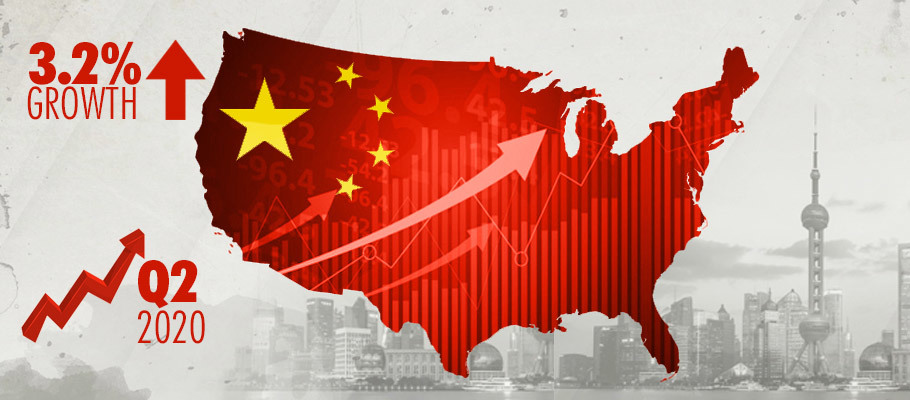
Published: July 22nd, 2020
China reported that its economy grew by more than 3% in the second quarter of 2020. This data indicates that the Asian country’s GDP shot above expectations. According to a poll that Reuters conducted, economists expected the Chinese economy to surge by a modest 2.5%. It is an impressive turnaround from the 7% decline that the country recorded in Q1. The results show that China is on a steady path to recovery from the coronavirus pandemic.
After a devastating Q1 2020, China has announced that its economy has rebounded by 3.2% in Q2. The slump in the first quarter was caused by the measures enforced to curb the spread of coronavirus, that erupted in Wuhan, in China’s Hubei province.
The measures that included a national lockdown paused the economic activity of the populous Asian country. As the country and most of the rest of the world move towards normalcy, China is recovering from earlier losses.
Two months earlier, China had reported a drop of almost 7% of the GDP in Q1 2020. The data that came from the country’s National Bureau of Statistics (NBSC) indicated that coronavirus was the culprit. The Q1 results are the first slump since China started releasing official quarterly records in 1992.
The growth comes as Beijing rolls out stimulus packages that China hopes will prop the domestic economy. According to NBSC, China’s economy overcame the adverse effects of the pandemic in the first half of 2020. The agency adds that the economy of the vast Asian country is showing gradual recovery, which manifests China’s vitality and development resilience.
Among the measures that Beijing has rolled out to boost the economy include additional fiscal spending, significant cuts in the base lending rates, and a further reduction in banks’ reserve requirements. The last aspect refers to the amount that the country’s central bank expects lenders to hold in reserve.
A poll by Reuters on 55 economists and financial analysts predicted that China would grow by 2.5% in Q2 of 2020. This poll showed that industrial growth would surge by 4.7% in June 2020 compared to the previous year.
The poll also forecasted a 0.3% increase in retail sales in the same month from -2.8% the previous month. However, fixed-asset investments were predicted to drop by 3.3% during the same period. The government agency’s report shows a better than expected performance compared to what the experts foresaw.
Following the easing of restrictions after the global lockdown, China’s dollar-dominated exports and imports shot up. The country’s customs data climbed with exports surging by 0.5% and the imports recording 2.7% increase.
However, the rise was not limited to just the dollar-dominated goods and services. The country’s customs agency indicated that the yuan-dominated exports also shot up by 4.3% compared to the same period last year while the value of imports increased by 6.2% year-on-year.
The June data also shows that the value of trade between China and the U.S. went up by more than $1.5 billion. The June figure stands at $29.41, which surpasses the $27.89 billion recorded in May 2020.
However, the state of the economy is in uncertainty following constant bickering between China and the U.S.
Washington is accusing China of not doing enough to contain the spread of the coronavirus.
According to the U.S. president, Donald Trump, the relationship between the world’s largest economies is severely damaged by the pandemic. Because of this situation, Trump says he is not keen on phase two of the deal with China. Instead, he is contemplating other things.
Besides, the recent action by China to pass a blanket security law for Hong Kong has further dented the relationship between the two counties.
According to the NBSC that relayed the positive results, China is doing well and recovering from the harsh effects of the coronavirus pandemic. This recovery is in stark contrast to the situation in most parts of the globe.
Gary Dugan, the CEO of the Global CIO Office, a leading investment firm in Asia, agreed with the assertions of NBSC. He said that China’s domestic demand is holding up well and even accelerating. He said that such a situation is good for the global commodities markets. It is also suitable for the growth of the world’s economy, Dugan concluded.
Bo Zhuang, the chief economist of China at TS Lombard, also agrees with the NBSC report and predictions. In a recent interview with CNBC, he said that he expects the ongoing recovery to continue for at least another two quarters. He added that with the increased growth in infrastructure development and resumption of movement in the provinces, the growth of 5% is possible in Q3 and Q4.
Despite a clean bill of health from some experts, a cross-section of economists holds the thought that the Chinese economy is not entirely out of the doldrums. The experts point that even though the recovery seems long-term, government support is still necessary.
Besides, Chinese factories are keeping up even though the demand from outside the country is still questionable. And, though consumer confidence is rising, it is yet to hit its peak. Experts think that tepid GDP growth may force the People’s Bank of China to step in.
And, with the third wave of coronavirus infections reported in Hong Kong, some cities may have to enforce restrictions if the said infections get to mainland China. Besides, there is a growing consensus among outsiders that China may be misrepresenting the data to paint a picture of success.
China released its Q2 GDP data which show that the economic growth surged by 3.2%. This figure surpasses the 2.5% growth prediction that economists polled by Reuters had forecasted. Most sectors seem to be on the rise following the easing of lockdown restrictions across the country. However, with uncertainty still clouding external demand for Chinese goods and the continued tiff between China and the U.S., a lot more still hangs on the balance.